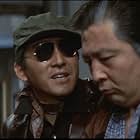Viewed at CineMatsuri 2015 and Streaming. Director Ken Ochiai's second theatrical film outing presents a one-of-a-kind story line and does so on many dramatic and technical levels. This is a tale of stunt men who specialize in supporting samurai movies shown in theaters and on TV. Like the real samurai before them, movie samurai are now all but extinct. But there is one last hurray to be had courtesy of a former novice stunt women who has moved on to become a major film star. Drifts toward melodrama and melancholy ("normally expected" given the downer subject matter) are held in check by a tight script and the Director's pro-active disciplining of his actors. Acting is exceeding professional (not surprising, since all but one are seasoned professionals). Actress Chihira Yamamoto is the exception. This appears to be her first theatrical film and acting debut. Her performance (line readings, facial expressions, body language, and physical action) is across-the-board astonishing. The movie contains slow intervals that attempt to dive more deeply into character development. Thankfully, there are only a few. The Director seems to have pursued a rigorous integration/exploitation of Japanese and American film-making cultures drawing on the best from each for the viewer's pleasure. (Likely the most successful venture of this kind to date!) As an added treat, the movie shows the functioning of behind-the-scenes production processes traditionally employed in the creation of movies by Kyoto-based studios (which are not the same as those used by Tokyo-based studios). Not unexpectedly, some processes are fairly similar to but others are quite different from contemporary methods used by American studios. During a post-showing Q&A with the Director (a graduate of two of the top film schools/programs in California), he described the challenges when confronting the super efficient Kyoto filming traditions where each scene is shot just once (with a single camera)! Cinematography (color, wide screen) and lighting are excellent. Film score is adequate (it neither over or under whelms). ADR (looping) and sound field production (5.1 channels) are very good. Western dialog (Kansai/Kyoto-Ben) is restrained perhaps to not overwhelm viewers who mostly speak/understand Toyko-Ben. Subtitles are spot on; just the right length to be read in a glance and minimize/avoid undue distractions. For what may be a first, the names of ALL above and below the proverbial line film contributors are translated in the closing credits! Worth re-watching several times. WILLIAM FLANIGAN, PhD.













